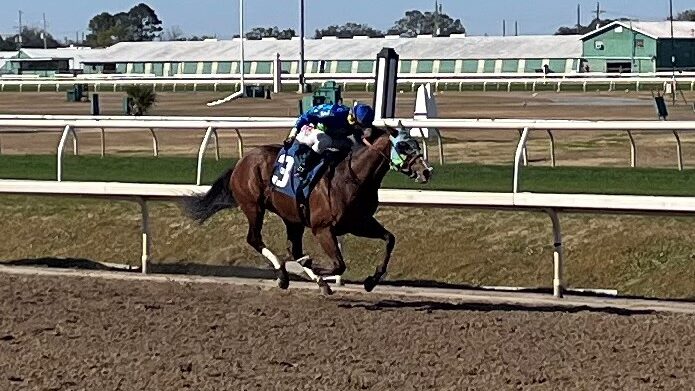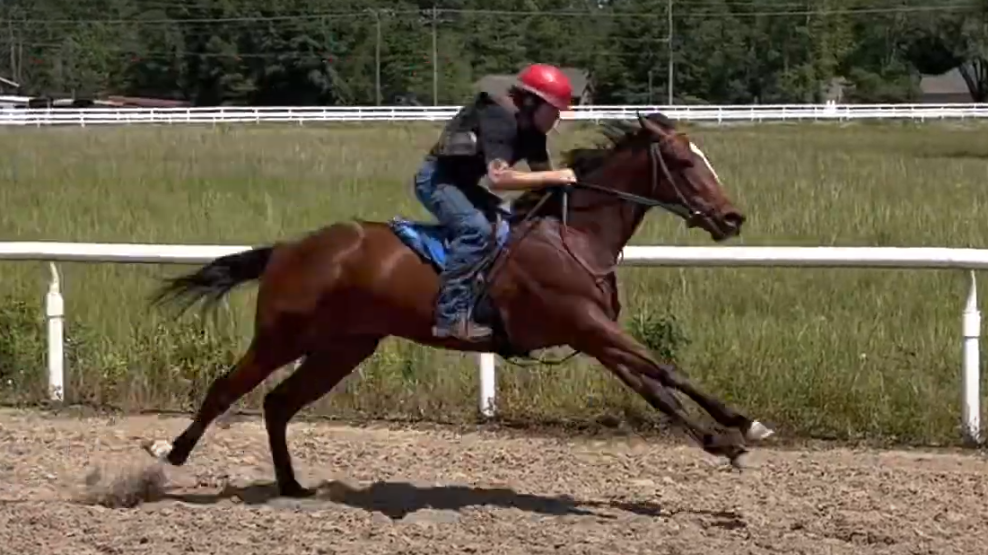How To Make A Horse Go Faster
Any links on this page that pb to products on Amazon are affiliate links and I earn a commission if you make a buy. Thanks in advance – I really appreciate it!
Have you noticed that certain jockeys ride an unusually high number of winners? Does the rider make the horse run faster? Or practice the more than successful jockeys ride, the amend horses? I did some inquiry to notice the respond.
Jockeys can and do make racehorses run faster. The unique movement of a rider on a horse's back "drives" a horse faster by creating kinetic energy. All racehorse jockeys ride similarly, but some jockeys are ameliorate than other jockeys at making their horse run more chop-chop.
Although jockey riding fashion can assistance a horse run faster, there is a lot more to riding a winning horse than how yous sit down on his back.

Contents
- 1 Study shows Jockeys can make a horse run faster.
- 2 "Monkey crouch" revolutionized horse racing.
- 3 Jockey motion reduces a equus caballus's workload.
- 4 Good horse racing Jockeys are fearless.
- 5 Top Jockeys know how to pace a horse.
- 6 Jockeys research the competition and track conditions.
- 7 Does Whipping a Horse Make It Run Faster?
- 8 Whipping a horse can't brand it run faster.
- 9 A whip encourages a equus caballus to continue running.
- 10 PETA wants whips in horseracing banned.
- 11 Horse whipping during races is monitored.
-
- xi.0.1 Related articles:
-
Study shows Jockeys can make a equus caballus run faster.
A London-based research group performed a study that proves that Jockeys tin can make racehorses run faster. Jockeys play a significant role in a horse's success during a race.
The London-based study revealed that Jockeys extend and constrict their legs, transmitting vertical force with their torso weight. With this activeness, the rider slightly overcompensates for the horse's motility. This movement requires substantial mechanical work past the jockey.
The result is that the equus caballus supports the jockey'due south weight just does non expend energy moving the rider. The kinetic free energy created by a jockey and horse might be slightly smaller than the horse lonely, and the jockey could "drive" the horse faster.
The ability to bulldoze a horse is possible because of the style of riding used by jockeys developed in America in the late 19th century.
"Monkey hunker" revolutionized horse racing.
The "monkey crouch" was first used in racing by an American jockey named Todd Sloan. He brought the manner to the Great britain in 1897 and revolutionized the earth of horse racing.
The new riding style didn't have legs downwardly his horse'due south sides simply bent knees with his feet placed in raised stirrups. The British coined the new look "monkey crouch." After implementing the "monkey crouch" style, equus caballus racing times improved by 5-7%.
A jockey is approximately 13% of the weight of a racehorse. Conveying a like-sized handbag of sand or a rider in a traditional non-crouch position takes the same amount of free energy from a horse.
The weight doesn't slow a equus caballus; the forward transportation of the weight slows a horse. Notwithstanding, jockeys in a crouch position assist a racehorse during its running stride past the energy the rider creates, thus allowing horses to run faster.

Jockey motion reduces a horse'south workload.
A jockey riding in a hunker position propels his body forrad with the horse and then the horse doesn't expend free energy moving the jockey. The piece of work required by a rider during a race will have his eye well-nigh-maximum beats per minute.
The London-based researchers confirmed their findings by measuring the dispatch and deportation of horses and riders using the Global Positioning System and sensors on horses and jockeys. The sensors allowed calculations of upwardly and down motility every bit well as the forward and aft movements.
The test showed that a jockey in a crouched position floated to a higher place a horse'due south back and saved the energy a equus caballus typically uses to lift and propel a load when running.
Good equus caballus racing Jockeys are fearless.
Good jockeys are intelligent, athletic, and fearless. Gamblers often say that the rider accounts for nigh ten per centum of a horse's performance in a race. Jockeys tin can't win on a mule, merely they tin influence good horses' ability to succeed.
Top jockeys take a feel for the horses they ride, and they know their horses' strengths and weaknesses. The best riders take a feel for when the equus caballus is ready to brand a movement and is not scared to thread between horses. A good jockey must exist fearless.
We recently had a jockey ride a young horse of ours, and he rode scared. Yous could see that he wanted to avert traffic at all costs. His poor ride led to a disappointing event.
Superlative Jockeys know how to pace a horse.
Horses run uniquely. Some horses kickoff wearisome and linger in the back of the pack before making a late movement. Other horses pause difficult from the gate and settle into a rhythm in the front of the pack. A practiced jockey knows what pace works best for his mount.

Jockeys inquiry the competition and track atmospheric condition.
Jockeys frequently research non only their mount just besides the competition. They cheque the racing forms and sentry videos. They get familiar with the track conditions, and all this information is processed and used during the race. Jockeys have to be smart.
Jockeys are small and wiry, just they are also strong and robust. Riders must exist strong to keep themselves counterbalanced on their toes and control a 1,100-pound animal traveling at 40 mph.
To remain strong and fit, a jockey has to eat right, work out and condition his trunk. Jockeys must exist able to drib a couple of pounds speedily without losing strength. If you want to learn more about jockeys, read our other article here on what a jockey wears or our commodity on how big horse jockeys are.
Does Whipping a Horse Brand It Run Faster?
When recently watching some horse racing, I noticed nigh of the horses were whipped when crossing the stop line. This made me wonder if whipping racehorses make them faster.
A whip can't make a equus caballus run faster than information technology can run. Researchers in Commonwealth of australia studied the whipping of horses in the terminal 400 meters of a horserace. They concluded that in that location is no correlation between chirapsia a tired horse and winning races.
The inquiry focused on horses' speed in the race'southward terminal stretch. The tests proved simply that tired horses being whipped by a jockey don't run as fast or faster than a fresh equus caballus. Even so, the test results are touted every bit proof that whipping a equus caballus doesn't help it run faster.
Whipping a horse can't make information technology run faster.
If this is truthful, so what is the advantage of whipping a equus caballus during a race? It'southward a tool used to communicate with horses. The whip translates the message that it'south time to start running faster. Horses are trained to react to cues from riders.
Equus caballus riders know a horse is encouraged to movement out with leg pressure. Yous also tin can become him to pick up the pace with trunk positioning and slight kicks. But some horses need more encouragement, a trivial more leg pressure, or a harder kick to get moving. Some horses even need to be ridden with spurs.

A whip encourages a horse to continue running.
The whip can be used; similarly, a jockey can show the horse the strap and hitting him lightly or even firmly to encourage him to choice up the stride during a race. The frequency and force of the strikes tell the horse to run and go along running until I stop.
Some horses get a good break from the starting gate, and the jockey volition ride them to the finish line without always touching them with the whip. Other horses will only crave encouragement by tapping his shoulder with the whip or placing it at the sight of the equus caballus.
Some horses may show signs of fatigue or exist maneuvered in and out of traffic on the course, and a jockey will whip the horse occasionally. The whip is also used often in the stretch of a race to proceed a equus caballus moving.
PETA wants whips in horseracing banned.
Animal rights organizations, including People for the Upstanding Treatment of Animals (PETA), experience whips should exist banned in horse racing. PETA cites the Australian written report mentioned higher up to support a ban on whips. PETA'south ultimate goal is the eradication of horse racing altogether.
PETA and other organizations accept garnered attention on the apply of whips in the racing industry. Because of their efforts, the Jockey Club and the Association of Racing Commissioners International (ARCI) formulated model rules for the pattern of whips. The whip standards:
- Weight: Whips to weigh no more than viii oz,
- Length: Whips to be less than 10 inches long
- Diameter: Shaft of whips at to the lowest degree 0.5 inches in diameter,
- Flap or popper: The flap or popper of a whip to be betwixt 0.8 and 1.6 inches wide.
- Pattern: To construct new whips: a four- or v-human foot tapered fiberglass rod is cut to whip length, wound with duct tape, and covered with material. A rubber handle is placed over the cloth, and the popper is added and glued in place.
The ARCI are guidelines only, and information technology is up to the various U.S. racing jurisdictions to gear up basic whip guidelines. In the U.S., regulations governing whip utilise vary among jurisdictions, with some racing jurisdictions adhering to the ARCI guidelines while others exercise not.

Horse whipping during races is monitored.
Track stewards are responsible for monitoring whip use at tracks in the United States. Canada, France, Australia, and the Britain, adopted strict rules regulating whip utilize during racing.
You tin can check out this article to learn more than about these countries' specific regulations regarding whip apply in equus caballus racing.
Some jurisdictions take set a limit on the number of times a jockey tin can strike a horse with a whip during a race. Requiring a passenger to count strikes seems an extreme asking. No one wants to run across whatever animal abused, but how is a jockey supposed to count the number of times he hits a equus caballus during a heated race?
Stewards or a console should determine if a jockey has gotten too forceful with a horse. If a steward believes a passenger is abusive, he could report the jockey to a lath and take the tape of the race reviewed.
The YouTube video below is an educational video that shows British jockeys the proper way to use a whip and illustrates riders positioning during a race.
Related articles:
- Why do Jockeys Habiliment Silks?
- How Jockeys Choose the Horse They Ride: All You lot Need to Know

I beloved animals! Especially horses, I've been around them nearly of my life but I am always learning more and enjoy sharing with others. I have bought, sold, and bankrupt racehorse yearlings. I accept raised some winning horses and had some that didn't brand information technology every bit racehorses, so we trained them in other disciplines.
Source: https://horseracingsense.com/how-do-jockeys-make-horses-go-faster/

0 Response to "How To Make A Horse Go Faster"
Post a Comment